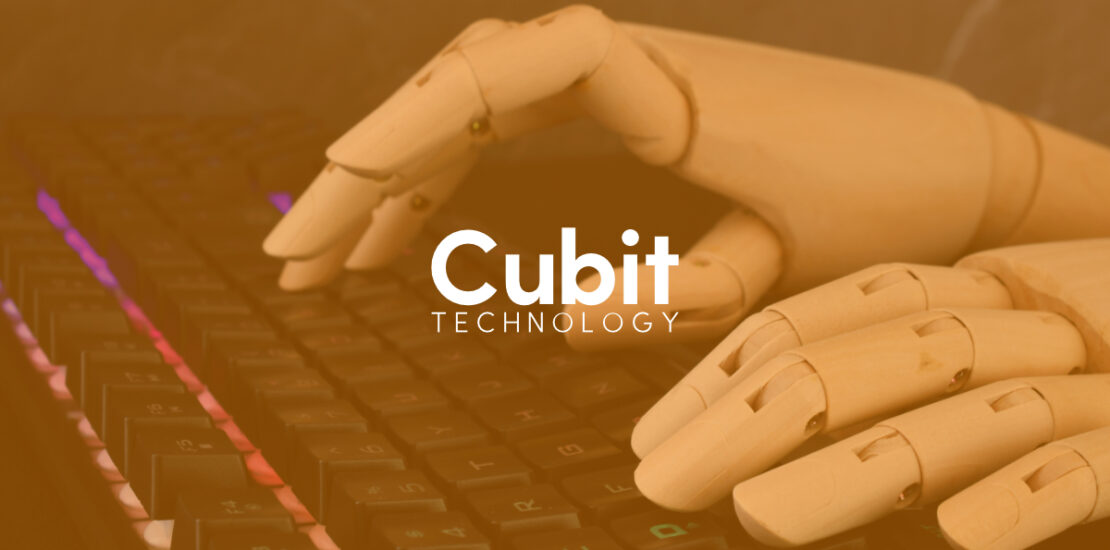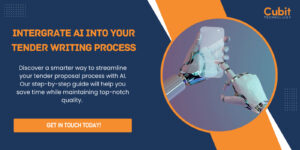How To Systematise Your Tender Proposals Using AI
- 18 October 2023
- Posted by:
- Category: Blogs

Utilise AI to Establish a Systematic Approach for Your Tender Proposals
Creating proposal documents in response to tenders can be a time-consuming process for agencies. What if there was a way to save time and be efficient, while avoiding compromising the quality and the effectiveness of your proposals? In this piece, we will give you a step-by-step guide for how you can integrate AI into your tender writing processes, using a data-driven approach that supports continuous improvements over time.
In our other recent pieces, we discussed how to use AI to write tender proposal content. Here, we focus on the wider process and how to systematise it. Without further ado, let’s get into it!
Aside from selecting an AI content tool to use for creating the proposals for you, we can break down the process into three key steps: 1) Bring your tender-relevant data together 2) Gather the tender requirements 3) use AI to draft the proposal according to a pre-defined proposal structure.
1. Bring your tender-relevant data together
The first step is to create and maintain a document that summarises your tender relevant data, this includes a range of potentially useful information that your agency will use for its tenders. This can include information about your agency’s values, specialities, awards it has earned, as well as quantitative data such as campaign performance figures for a particular industry that you service.
By bringing your tender-relevant data together into one documented place, you will be able to use AI to scan and harness it to write a proposal that relates this data to the tender requirements.
For example, a tender from a construction company that values sustainability can be addressed using campaign performance metrics that an agency has for clients within that industry, as well as content in the document that addresses the theme of sustainability. The same is true for other sectors, such as local authorities, and focuses they will have, such as data protection and certification requirements under the Cyber Essentials scheme.
Here are the kinds of data you may want to consider bringing together:
- Data relevant to eligibility criteria: your agency’s location, size, target industry, experience and certifications
- Performance Data: Campaign and client-wide marketing performance data, that can also be broken down by sector, marketing service, and channels for example.
- Values and Approach: Articulate what your marketing or creative agency stands for and how its approach within the market distinguishes it from the competition.
- Wider market data: This could be industry data, marketing trends, information about how consumer behaviour is changing, and so on. This kind of data can be leveraged for example to justify the effectiveness of a particular approach, strategy, or to point to why your past projects with similar clients have been successful.
- Past Tender Feedback: You can include past feedback from tender submissions as factors for the AI to bear in mind and address, especially if the themes of the feedback are relevant to the prospective client’s requirements and priorities in their tender document.
Ensuring that the data is recent, relevant, well-structured, and broken down will help AI tools to properly marshal it for creating an excellent initial draft. Take care to ensure the AI tool that you use can support elements such as tables of data for the best results.
Consider also automating aspects of this, for example, you may have a database or a spreadsheet that can be updated in real time with performance data. This could be embedded into your Word document as a live table, which takes care of the need for updating the data in the document.
2. Gather the tender requirements
You now have a wealth of written and numerical data available for use by a speedy and intelligent AI. You now just need to bring the contents of the tender document into play so that the AI can work its magic.
You can either bring the tendering document and your tender bidding document’s contents together on a software platform, entering it all as a prompt; or you can bring them together in a single document and upload it to an AI content platform that uses a document as its dataset.
Ahead of prompting the AI to draft a proposal, you may want to also have a template proposal structure in place that you can use to guide how the proposal will be structured by the AI. In total you should have:
- A tender proposal data document (step 1)
- The tender document with the brief and requirements
- A template proposal structure for guiding the AI’s content creation
3. Draft the proposal according to a pre-defined structure
With these three ingredients together, you can now get AI to write a relevant, tailored and comprehensive proposal according to a structure.
Bring the data together in a document and prompt the AI to write a proposal that addresses the requirements, context and goals of the prospective client, by tailoring the response using your tender-relevant data. Use the prompt to make the desired structure clear by giving an example. Finally, add any other details that can help, such as guiding the tone of voice of the proposal, and what it should emphasise throughout the draft.
Optimising Your Tender Proposals
Optimising proposals works at two levels, each tender proposal document in itself, and your wider tender proposal efforts.
For the document itself, it will remain important to go through and refine it to bring your agency’s voice and additional nuances into the document. Other details, such as any proposed budget and milestones will also need to be included.
At a broader level, you can use feedback from potential clients to further refine your documentation and how the AI uses it to craft proposals, enabling it to get more things right at each iteration of the process. Take care to track metrics such as how long it takes to create and submit proposals with the help of AI, and crucially, the success rate of AI-assisted proposals.
Conclusion
In this guide we give a potential way for your creative agency to systematise and enhance its tender proposal submission efforts, enabling it to submit tenders more quickly and seamlessly. AI can act as an assistant for speeding up the completion of compelling tender proposals, and can even potentially contribute to a greater success rate for your agency. By getting creative and using AI to enhance your workflows and processes, you can save time and leverage it to apply the creative power of your team to make a difference for your existing and potential clients alike.
Cubit Technology – Impactful IT Support and Management for London’s Creative Sector
Nestled in the dynamic heart of Central London, Cubit Technology is your foremost destination for a wide range of IT solutions and support services. Located in the bustling city of London, our dedicated team specialises in providing IT support, management, and consultancy services designed specifically to empower businesses within London’s creative sector, including those engaged in marketing, design, and related industries. Our goal is to facilitate your growth and success by harnessing the power of technology.
At Cubit Technology, we recognise the distinctiveness of each creative business, which is why we adopt a tailored and multi-disciplinary approach. We empower creatives to flourish in diverse IT environments, whether it be on-premises, hybrid, cloud-based, or across both PC and Mac setups. Contact us today and elevate your business to new heights within the bustling metropolis of London!
